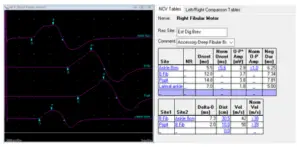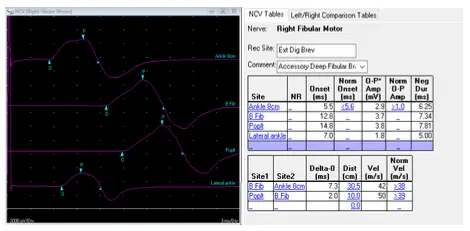Recently a patient was referred to us with possible Lumbar radiculopathy.
Emory Healthcare defines lumbar radiculopathy as a disease involving the lumbar spinal nerve root. This can manifest as pain, numbness, or weakness of the buttock and leg.
Dr. Martinos performed an electromyograph (EMG) on the patient to learn more about the cause of this issue is. An EMG is defined as an electrodiagnostic testing technique. It is used evaluating and recording the electrical activity produced by skeletal muscles.
When stimulating the fibular (peroneal) motor nerve with maximal recruitment, we should always have a greater amplitude at the most distal stimulation point. However, every now and again there will be a loss of amplitude most distally.
What happened?
If we stimulate at the lateral ankle, we can see that this patient has an accessory deep fibular (peroneal) nerve branch present. The sum of the lateral ankle and ankle at 8 cm is 4.7 mV which is consistent with an accessory fibular (peroneal) nerve response and the sum is greater than the proximal simulation amplitudes.

“The accessory deep peroneal (ADPN) nerve has been regarded as an anomalous nerve derived from the superficial peroneal nerve or its branch and supplies motor innervations for extensor digitorum brevis (EDB) and sensory innervations for the lateral part of the ankle and foot regions. The EDB is usually innervated exclusively by the deep peroneal nerve, a major branch of the common peroneal nerve, however, in as many as 28% of patients, one or both of the EDB muscles are (partially or exclusively) innervated by the ADPN nerve. ADPN existence can be of great clinical and surgical importance, in very rare cases of coexistence ADPN and anterior tarsal tunnel syndrome.” 1
In conclusion, the test determined that the patient’s condition was not pathologic. It was instead a normal variation. Even more interesting is that this is something not see very often. It’s something that many people don’t see or recognize.
EMG Solutions is comprised of physical therapists like Dr.Martinos who delivered this test. All are board-certified electrophysiologic clinical specialists trained to perform EMG. Studies show that EMG’s performed by physical therapists maintains the gold standard quality when compared to all other providers.
Learn more about our expanding partner list that EMG Solutions works with.
- Sinanović O, Zukić S, Šakić A, Muftić M. The accessory deep peroneal nerve and anterior tarsal tunnel syndrome: case report. Acta Myol. 2013;32(2):110-2. https://www.ncbi.nlm.nih.gov/pubmed/24399869



